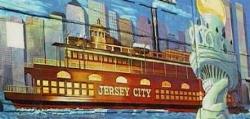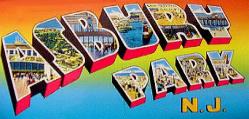 |  |  |
|
| ||
 |  |  |
 |  |  |
|
| ||
 |  |  |
|
|
George H. Cook,
STATE GEOLOGIST.
Edited by GET NJ
Copyright 2003
The records cited show that the
partition line between the two States, as marked in 1774, was traced with
the compass; that it was run from both ends; and that on account of local
attraction some parts of the line were traced by staking. The work of this
summer, as exhibited on the maps herewith presented, shows that the
monuments as they now stand are not in a straight but in a crooked line,
in which every mile-stone is south of the straight line. There is no doubt
the line was crooked when it was run through in 1774, for a long line upon
a single course, traced with the surveyors compass, would necessarily be
crooked. In navigation where the compass is constantly moving with the
vessel and is kept steadily on any oblique course, the track of the vessel
is in a curve which is called a rhumb line or loxodromic curve. This is
produced by the needle making the same angle with all the meridians it
crosses, while the meridians are not parallel to each other but all
converging
towards the poles of the earth. In using the compass on land, on long
lines, the instrument is set up on the proper bearing of the line, and a
mark is fixed as far ahead as clearness of vision or other causes will
permit; and the instrument is carried forward to the mark and set up with
the sam e bearing as before, and another mark made as far ahead as
possible, and so on through the whole distance to be run. In this way the
lines from one station to another are straight lines, but making with each
other small angles corresponding to the convergency of the meridians of
the stations. In proportion as the number of stations is increased, and
the distance between them diminished, so the curvature of this line is
increased. It cannot be otherwise than that a long line, on any oblique
bearing, run in this way, will be crooked, more or less, according to the
number of parts in which it has been run; and it cannot be accurately
retraced unless the several stations occupied at the first running are
known and used again.
The difference in the variation of the needle at the
two ends of a long line, as in the present case where the difference is 2
deg. and the line 48 1/2 miles long, must also interfere greatly with running
a straight line with the compass, as there would necessarily be at least 2
deg. difference in the direction of the line run, if the magnectic bearing
was continued the same throughout. The difficulty of the case is still
greater from the variation being irregular, geatest at the east end less
at the west, and least at some intermediate point. See tabular statement
of Prof. Bowser.
Local attraction is very common and strong, particularly
so, in the iron-ore district, traversed by the middle parts of this line,
and from the appearance of the line as the monuments stand, it would seem
as if this cause must have interfered to increase the inaccuracy of the
work. With all these agencies to affect their work, it will be understood
that the surveyors could not with the instruments then used, trace a long
straight line accurately between two given points.
 Your Ancestors' Story |
 Bruce Springsteen's Jersey Shore Rock Haven! |

|
UrbanTimes.com |